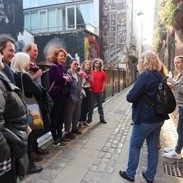Accessibility Statement for the VisitBritain Industry website
VisitBritain/TAG

Accessibility Statement
This accessibility statement applies to the https://www.visitbritain.org domain.
This website is run by the British Tourist Authority t/a VisitBritain. We want as many people as possible to be able to use this website. For example, that means you should be able to:
- change colours, contrast levels and fonts
- zoom in up to 400% without the text spilling off the screen and without content being truncated or overlapping
- navigate most of the website using just a keyboard
- navigate most of the website using speech recognition software
- listen to most of the website using a screen reader (including the most recent versions of JAWS, NVDA and VoiceOver)
Not all of these are currently possible as described below. However, we will deploy fixes in batches, and all the non-conformances will be fixed by 31 March 2024.
We’ve also made the website text as simple as possible to understand.
AbilityNet has advice on making your device easier to use if you have a disability.
How accessible this website is
We know some parts of this website are not fully accessible:
Issues affecting people with low vision
- On pages containing content filters, the selected state of the filter buttons is only conveyed visually by means of a change of background colour that may not be perceptible.
- In a small number of cases, links are only differentiated from the surrounding text by a difference in colour that may not be perceptible.
- When the content filtering options are changed, a horizontal progress indicator is displayed, but the difference in colour between the “completed” and “not completed” parts of the indicator may not be perceptible.
- Some of the text in third-party content does not have sufficient colour contrast. This occurs in the Google maps, YouTube videos and the CAPTCHA in forms.
- In the YouTube video player, many of the media player controls do not have sufficient colour contrast. Also, none of the focus indicators have sufficient colour contrast.
- When the content filtering options are changed, pages can take 20 seconds or more to update if the network connection is slow. The progress indicator does not have sufficient colour contrast.
- In the newsletter sign-up forms, the textbox and checkbox borders do not have sufficient colour contrast. Also, the Close buttons for the error messages do not have sufficient colour contrast.
Issues affecting people who use the browser’s zoom feature
- In the “Information for…” overlay, the Close button overlays some of the text at 300% browser zoom. Also, only part of one of the six carousel slides is visible at 400% browser zoom. The Next Slide and Previous Slide buttons are off the screen, and it is not possible to bring them into view, so no other slides can be viewed.
- In the YouTube video overlay, the Settings button is not displayed at 400% browser zoom, so it is not possible to set options including the video speed, video quality and captions appearance.
- In some carousels, it is not possible to view all the content of each slide at 175% browser zoom and above when using keyboard navigation because part of each slide is off the screen.
- In the newsletter sign-up forms, the Privacy and Terms links in the CAPTCHA are not visible at 400% browser zoom. They are off the screen to the right, but there is no horizontal scrollbar, so it is not possible to scroll across to access them.
- In some Research Insights pages, some of the filenames under the “Further resources” heading are truncated at 400% browser zoom.
Issues affecting people who use keyboard navigation
- If the accordion bars have focus, the “up arrow” and “down arrow” keys cannot be used to scroll the page up and down. The “Page Up” and “Page Down” keys work, but this does not give the fine control that may be desired or necessary.
- In the YouTube embedded media player, the “precise seeking” feature cannot be accessed using keyboard controls.
- It is difficult to view some carousels when using keyboard navigation. In some cases, is necessary to navigate through all the slides. Some slides do not move fully into view when they receive focus, so it is difficult to read their content. Some other slides do not move into view at all when they receive focus. When the Previous and Next buttons are operated, the focus automatically moves to the start of the carousel instead of staying on the button.
- In the mobile layout, when the “Open menu” button is operated using keyboard controls, the focus remains on it (even though it is now hidden) instead of moving to the “Close menu” button that is displayed in its place. Also, when a drilldown menu is opened using keyboard controls, the focus is placed on the first menu item instead of the “Main Menu” link that is before them.
- The Search form opens in an overlay. When the “Close search” button is operated, the focus is placed in the Search textbox, even though it is no longer visible, instead of remaining on the button (whose name changes to “Open search”).
- Some pages contain “jump links” that are displayed as a dropdown list in the mobile layout. The button that opens and closes the dropdown is after the list of links, so it is necessary to navigate backwards to access them after opening the dropdown.
- The YouTube videos are displayed in overlays. The overlay is supposed to trap the focus, but it does not when using Chrome on Android, so it is easy to accidentally navigate into the page behind the overlay in which case the focus indicator may no longer be visible.
- At 175% browser zoom and above, it is not possible to view all the content of some carousel slides when using keyboard navigation because part of each slide is off the screen.
Issues affecting screen reader users
- In the interactive maps, the map pins are images that do not have text alternatives, so screen reader users do not know what they are.
- Videos do not have an audio description to describe the important visual content.
- The navigation menus are not coded as nested lists, so it is difficult to understand the structure.
- It is not possible to read the “Credit text” for the images.
- Some complex components, such as accordions, content filters and carousels may be difficult to understand.
- In the forms, the error messages next to each textbox may not be announced, but there is a list of the errors at the top of the form.
- Some headings are not the correct level, so it may be difficult to understand the structure of some content.
- The website contains several overlays that are supposed to trap the focus while you interact with their contents. However, with some screen readers it is possible to navigate out of the overlay, into the rest of the page, which could be confusing and make it difficult to find the overlay content again.
- The column headings are not marked-up correctly in some data tables. The tables are small and simple, so this should not be a significant issue.
- When the content filtering options are changed, pages can take 20 seconds or more to update if the network connection is slow. There is no audible indication of what is happening, what the progress is or when the content has been fully updated.
- On some Research Insights pages, content is displayed as a set of “cards”. In each card, there is an image before the card’s heading. Screen reader users are likely to incorrectly conclude that the image is associated with the preceding heading, not the following heading.
- On pages that contain an embedded YouTube video, numerous single character key shortcuts are active when the focus is anywhere in the YouTube player. This may interfere with the screen reader’s shortcut keys.
- The “Information for…” link in the header opens an overlay, but the focus does not move into it when using a screen reader, so it is not possible to access the links in the overlay.
- The list of venues next to the interactive maps contains a number of “View on map” links, but it is not clear which venue each link refers to. The same occurs elsewhere in the website with various phrases such as “Find out more”, “Download” and “Watch”.
- Some of the top-level menu items are buttons that open dropdown menus. When they are operated using JAWS or NVDA screen readers, the current page reloads instead of the dropdown menu opening.
- When filters are applied on the search results page, a “Current filters” panel is added, containing links to remove the filters. The link name is just the filter name, such as “Business events”, which does not convey the purpose of the link.
Issues affecting screen magnifier users
- In the main menu, dropdown menus are displayed when the mouse is hovered over some of the top-level menu buttons. The dropdown menus cannot be dismissed without moving the pointer hover.
- In the YouTube video player, tooltips are displayed when hovering over the media player buttons. They disappear if the mouse is moved over them.
Issues affecting voice recognition software users
- Some pages contain a “Not found what you were looking for?” form. The most obvious visual label is the placeholder text “Enter search terms here”. However, this cannot be used to target the textbox. Just use the word “Search” instead.
Documents
The website contains approximately 1000 PDFs and office documents. We are gradually replacing or removing any inaccessible documents created since 23 September 2018 and expect to complete this by 31 September 2025.
Interactive visualisations
A few pages in the Research Insights section contain interactive visualisations of International Passenger Survey data that are not fully accessible. These are implemented using Microsoft PowerBI and we are currently working on improvements to them. We have provided the data in several other formats and are working to improve the offering.
Feedback and contact information
If you need information on this website in a different format like large print, Easy Read, audio recording or Braille:
- email [email protected]
- call +44 (0) 20 7578 1400
We’ll consider your request and get back to you in 10 days.
Reporting accessibility problems with this website
We’re always looking to improve the accessibility of this website. If you find any problems not listed on this page or think we’re not meeting accessibility requirements, contact:
- email [email protected]
- call +44 (0) 20 7578 1400
Enforcement procedure
The Equality and Human Rights Commission (EHRC) is responsible for enforcing the Public Sector Bodies (Websites and Mobile Applications) (No. 2) Accessibility Regulations 2018 (the ‘accessibility regulations’). If you’re not happy with how we respond to your complaint, contact the Equality Advisory and Support Service (EASS).
Technical information about this website’s accessibility
The British Tourist Authority is committed to making the VisitBritain Industry website accessible, in accordance with the Public Sector Bodies (Websites and Mobile Applications) (No. 2) Accessibility Regulations 2018.
Compliance status
This website is partially compliant with the Web Content Accessibility Guidelines version 2.1 AA standard, due to the non-compliances and exemptions listed below.
Non-accessible content
The content listed below is non-accessible for the following reasons.
Non-compliance with the accessibility regulations
WCAG 2.1 level A
- In the interactive maps, the map pins are images that do not have text alternatives. WCAG 2.1 SC 1.1.1 (Non-text Content)
- Videos do not have an audio description to describe the important visual content. WCAG 2.1 SC 1.2.3 (Audio Description or Media Alternative (Pre-recorded))
- The top-level menu and submenus are contained by list elements, which is normal, but their list item elements have role=”none” attributes, so the list elements effectively do not contain any list items. WCAG 2.1 SC 1.3.1 (Info and Relationships)
- The dropdown menus only contain one list item element that contains a paragraph of text and multiple menu links. WCAG 2.1 SC 1.3.1 (Info and Relationships)
- The “Credit text” buttons for the images are constructed incorrectly, so the credit text is not conveyed programmatically. WCAG 2.1 SC 1.3.1 (Info and Relationships)
- The expanded / collapsed state of the “Credit text” buttons is not conveyed programmatically. WCAG 2.1 SC 1.3.1 (Info and Relationships)
- Visually, it is obvious that the accordion sections are related, but there is no programmatic relationship between them. WCAG 2.1 SC 1.3.1 (Info and Relationships)
- The accordion bars are not constructed correctly. WCAG 2.1 SC 1.3.1 (Info and Relationships)
- Some content filters work in conjunction with carousels, but they are not grouped or otherwise related programmatically. WCAG 2.1 SC 1.3.1 (Info and Relationships)
- Some carousels and carousel slides are not grouped programmatically and/or labelled appropriately. WCAG 2.1 SC 1.3.1 (Info and Relationships)
- In the forms, the inline error messages are not programmatically associated with the corresponding input field. Also, the inline error messages are hidden from assistive technologies. WCAG 2.1 SC 1.3.1 (Info and Relationships)
- Some headings are not the correct level. WCAG 2.1 SC 1.3.1 (Info and Relationships)
- Some overlays should be modal, but they are not with some or all browsers and assistive technologies. WCAG 2.1 SC 1.3.1 (Info and Relationships)
- The column headings are not marked-up correctly in some data tables. WCAG 2.1 SC 1.3.1 (Info and Relationships)
- When the content filtering options are changed, pages can take 20 seconds or more to update if the network connection is slow. A visual progress indicator is displayed during this time, but the progress and completion are not conveyed programmatically. WCAG 2.1 SC 1.3.1 (Info and Relationships)
- On some Research Insights pages, content is displayed as a set of “cards”. In each card, there is an image before the card’s heading. Non-visual users are likely to incorrectly conclude that the image is associated with the preceding heading, not the following heading. WCAG 2.1 SC 1.3.2 (Meaningful Sequence)
- On pages containing content filters, the selected state of the filter buttons is only conveyed visually by means of a change of background colour. WCAG 2.1 SC 1.4.1 (Use of Colour)
- In a small number of cases, links are only differentiated from the surrounding text by means of colour. WCAG 2.1 SC 1.4.1 (Use of Colour)
- When the content filtering options are changed, a horizontal progress indicator is displayed, but the difference in colour between the two parts of the indicator is not sufficient. WCAG 2.1 SC 1.4.1 (Use of Colour)
- When using keyboard navigation, if the accordion bars have focus, the “up arrow” and “down arrow” keys cannot be used to scroll the page up and down. The “Page Up” and “Page Down” keys work, but this does not give the fine control that may be desired or necessary. WCAG 2.1 SC 2.1.1 (Keyboard Navigation)
- In the YouTube embedded media player, the “precise seeking” feature is accessed by dragging the timeline up with a pointing device. This feature cannot be accessed using keyboard controls. WCAG 2.1 SC 2.1.1 (Keyboard Navigation)
- When using keyboard navigation, it is necessary to navigate through all the slides of some carousels. Some slides do not move fully into view when they receive focus, so it is difficult to read their content. Some other slides do not move into view at all when they receive focus. When the Previous and Next buttons are operated, the focus automatically moves to the start of the carousel instead of staying on the button. WCAG 2.1 SC 2.1.1 (Keyboard Navigation)
- On pages that contain an embedded YouTube video, numerous single character key shortcuts are active when the focus is anywhere in the YouTube player, not just when the focus is on the relevant control. WCAG 2.1 SC 2.1.4 (Character Key Shortcuts)
- On search results pages, the page title is just the search term. WCAG 2.1 SC 2.4.2 (Page Titled)
- In the mobile layout, when the “Open menu” button is operated using keyboard controls, the focus remains on it (even though it is now hidden) instead of moving to the “Close menu” button that is displayed in its place. Also, when a drilldown menu is opened using keyboard controls, the focus is placed on the first menu item instead of the “Main Menu” link that is before them. WCAG 2.1 SC 2.4.3 (Focus Order)
- The “Information for…” link in the header opens an overlay, but the focus does not move into it when using a screen reader, so it is not possible to access the links in the overlay. WCAG 2.1 SC 2.4.3 (Focus Order)
- The Search form opens in an overlay. When the “Close search” button is operated, the focus is placed in the Search textbox, even though it is no longer visible, instead of remaining on the button (whose name changes to “Open search”). WCAG 2.1 SC 2.4.3 (Focus Order)
- Some pages contain “jump links” that are displayed as a dropdown list in the mobile layout. The button that opens and closes the dropdown is after the list of links, so it is necessary to navigate backwards to access them after opening the dropdown. WCAG 2.1 SC 2.4.3 (Focus Order)
- The YouTube videos are displayed in overlays. The overlay is supposed to be modal, but it is not when using Chrome on Android. WCAG 2.1 SC 2.4.3 (Focus Order)
- The list of venues next to the interactive maps contains a number of “View on map” links whose purpose cannot be determined from the link text alone or from the link text together with their programmatically determined link context. The same occurs elsewhere in the website with various phrases such as “Find out more”, “Download” and “Watch”. WCAG 2.1 SC 2.4.4 (Link Purpose (In Context))
- Some pages contain a “Not found what you were looking for?” form. The textbox’s label is not included in the accessible name. WCAG 2.1 SC 2.5.3 (Label in Name)
- In the mobile menu, submenus contain a “Main Menu” link, but the link element does not have an “href” attribute. WCAG 2.1 SC 4.1.2 (Name, Role, Value)
- When filters are applied on the search results page, a “Current filters” panel is added, containing links to remove the filters. The link name is just the filter name, such as “Business events”, which does not convey the purpose of the link. WCAG 2.1 SC 4.1.2 (Name, Role, Value)
WCAG 2.1 level AA
- Videos do not have an audio description to describe the important visual content. WCAG 2.1 SC 1.2.5 (Audio Description (Pre-recorded))
- In the newsletter sign-up forms, none of the textboxes has the required “autocomplete” attributes. WCAG 2.1 SC 1.3.5 ( Identify Input Purpose)
- Some of the text in third-party content does not have sufficient colour contrast. This occurs in the Google maps, YouTube videos and the CAPTCHA in forms. WCAG 2.1 SC 1.4.3 (Colour Contrast)
- At 175% browser zoom and above, it is not possible to view all the content of some carousel slides when using keyboard navigation because part of each slide is off the screen. WCAG 2.1 SC 1.4.4 (Resize Text)
- In the “Information for…” overlay, the Close button overlays some of the text at 300% browser zoom. Also, only part of one of the six carousel slides is visible at 400% browser zoom. The Next Slide and Previous Slide buttons are off the screen and it is not possible to bring them into view, so no other slides can be viewed WCAG 2.1 SC 1.4.10 (Reflow)
- In the YouTube video overlay, the Settings button is not displayed at 400% browser zoom, so it is not possible to set options including the video speed, video quality and captions appearance. WCAG 2.1 SC 1.4.10 (Reflow)
- In some carousels, it is not possible to view all the content of each slide at 175% browser zoom and above when using keyboard navigation because part of each slide is off the screen. WCAG 2.1 SC 1.4.10 (Reflow)
- In the newsletter sign-up forms, the Privacy and Terms links in the CAPTCHA are not visible at 400% browser zoom. They are off the screen to the right, but there is no horizontal scrollbar so it is not possible to scroll across to access them. WCAG 2.1 SC 1.4.10 (Reflow) -In some Research Insights pages, some of the filenames under the “Further resources” heading are truncated at 400% browser zoom. WCAG 2.1 SC 1.4.10 (Reflow)
- In the YouTube video player, many of the media player controls do not have sufficient colour contrast. Also, none of the focus indicators have sufficient colour contrast. WCAG 2.1 SC 1.4.11 (Non-text Contrast)
- When the content filtering options are changed, pages can take 20 seconds or more to update if the network connection is slow. The progress indicator does not have sufficient colour contrast. WCAG 2.1 SC 1.4.11 (Non-text Contrast)
- In the newsletter sign-up forms, the textbox and checkbox borders do not have sufficient colour contrast. Also, the Close buttons for the error messages do not have sufficient colour contrast. WCAG 2.1 SC 1.4.11 (Non-text Contrast)
- In the main menu, dropdown menus are displayed when the mouse is hovered over some of the top-level menu buttons. The dropdown menus cannot be dismissed without moving the pointer hover. WCAG 2.1 SC 1.4.13 (Content on Hover or Focus)
- In the YouTube video player, tooltips are displayed when hovering over the media player buttons. They are dismissable, and persistent, but they are not hoverable. WCAG 2.1 SC 1.4.13 (Content on Hover or Focus)
- When the content filtering options are changed, pages can take 20 seconds or more to update if the network connection is slow. The progress indicator is a status message but cannot be programmatically determined through role or properties such that it can be presented to the user by assistive technologies without receiving focus. WCAG 2.1 SC 4.1.3 (Status Messages)
Content that’s not within the scope of the accessibility regulations
- legacy PDFs and other office documents published before 23 September 2018
- online maps
- embedded YouTube media player
What we’re doing to improve accessibility
We have conducted a thorough accessibility test of all the different content types and page templates. We will deploy fixes in batches, and all the non-conformances will be fixed by 31 March 2024.
Preparation of this accessibility statement
This statement was prepared on 03 October 2023. It was last reviewed on 03 October 2023.
This website was last tested on 02 October 2023. The test was carried out by Test Partners Ltd.
We followed GOV.UK guidance on deciding how to select the sample of pages to test:
- We used an automated website mapping tool to identify all the pages on the website.
- We grouped the pages according to type, such as all the Business Advice pages, Destinations pages, News and Media pages etc.
- We manually assessed a number of pages from each group to determine the level of consistency within the group and the type of content on those pages.
- We manually assessed all the “unique” pages such as the home page and search results to determine the type of content on those pages.
- We identified a minimum representative subset of pages that contain examples of the most common layouts, components and features, including:
- The header and footer.
- Important “unique pages”.
- Pages with text content and data tables.
- Interactive elements such as forms, carousels, accordions, content filtering, video content, interactive maps etc.
- AJAX content loading.
- We conducted a manual WCAG audit on the representative subset of pages.
- We have conducted one round of fixing and retesting.
- Further rounds of fixing and retesting will be conducted until all the WCAG non-conformances have been fixed.






